Lingual Braces vs. Invisalign: Which Is Better?

As modern technology has advanced, so have the opportunities to straighten teeth in a multitude of ways. Because of this, lingual braces and Invisalign have become popular options for orthodontic care due to their discretion and near-invisibility. While lingual braces have brackets and wires attached to the backside of the teeth, Invisalign offers braces-free care with the use of clear, removable aligners. Both options have their pros and cons, and should be chosen upon an individual’s needs and wants. Find out whether lingual braces or Invisalign is the best option for your orthodontic needs with this guide!
What Are Lingual Braces?
Millions of teenagers and adults have braces put on each year, and most pick the traditional metal braces that we’re all so used to seeing. However, traditional braces can be bulky, annoying and embarrassing for teenagers and adults alike, and many patients feel like they’re distracting. Lingual braces are another option for patients who prefer invisible treatment over big, bulky braces, plus they can achieve the same straight, beautiful teeth that other treatments provide. Instead of wearing braces on the outside of teeth, lingual braces attach the brackets and wires to the backside (lingual side) of teeth for an inconspicuous and nearly-invisible treatment. Other than aesthetic concerns, patients opt in for lingual braces as they make it easier to play wind instruments, such as the flute or tuba, and they’re more functional for athletes that play contact sports. However, not every orthodontic office offers lingual braces; orthodontists have to complete specialized training to be able to install lingual braces, so you’ll have to do your research to find out who in your area is qualified to perform treatment.
Additionally, lingual braces can take longer to get used to since they’re on the backside of your teeth, close to your tongue. They can make swallowing more difficult as the tongue can’t thrust between your teeth as easily as it could before. Patients also have to have long enough teeth to provide enough room for the braces to be glued onto them, so children and those with small teeth typically don’t qualify for this type of treatment. Lastly, treatment time is usually longer with lingual braces than traditional braces. The entire process depends on your orthodontist and how well you take care of your teeth during treatment, so treatment time varies from patient to patient.
How Invisalign Works
Another option for patients who prefer invisible orthodontic care is Invisalign, which uses clear, removable aligners to fix malocclusion over a period of several months or years. Some patients highly dislike the look of metal braces, lingual or not, and Invisalign offers them the care they need without having to sacrifice their confidence at work or social events. Many enjoy Invisalign because its unique treatment allows them to remove their orthodontic device during eating, drinking, flossing and brushing, making these daily activities much more manageable. They let you eat all of your favorite foods, you can’t break a wire or bracket, oral hygiene isn’t hindered and they’re virtually invisible.
Wearing Invisalign retainers does take time, effort and patience, however. One aligner is worn for one to two weeks before replacing it with the next one in line. You’ll have a checkup every six to eight weeks to monitor your teeth and receive a new batch of aligners to wear for the next several weeks. During this time, Invisalign aligners need to be worn for 20-22 hours of the day, which is a huge commitment for busy people. Aligners also need to be carefully washed and cleaned with a toothbrush each night to keep bacteria from growing. Since they’re removable, Invisalign aligners can be easily lost, misplaced or broken by a fall or child, so extreme care will be necessary to keep them intact.
Making A Choice
Both lingual braces and Invisalign are viable options for patients who want orthodontic care that is undetectable and discreet, but whichever you choose is up to you and your orthodontic needs. The first step that you’ll need to take is to visit with your orthodontist for an evaluation of your teeth and to discuss which of the two would work best for your wants and needs, plus the orthodontist’s recommendation. Remember that while Invisalign is a great option for those who want to take their orthodontic care into their own hands, it requires extreme responsibility and care for the aligners you’ll be using. Lingual braces, on the other hand, will always remain in your mouth, so you won’t need to worry about losing anything like you do with Invisalign, but flossing and brushing can be more difficult as you’ll have to do it all from the backside of your teeth. Your choice should be based on what you are willing and not willing to do during treatment, so do your research on both options to be fully informed on what to expect.
Schedule Your Consultation
To be evaluated for lingual braces or Invisalign, call Belmar Orthodontics at (303) 225-9016 to schedule a consultation. Our team is qualified and experienced at installing both lingual braces and Invisalign, plus we can give you extra tips on how to keep your teeth brilliant and healthy during treatment. Call today to start your journey to a more beautiful smile!
How Invisalign Can Increase Teens’ Confidence

While many teenagers need orthodontic care, some don’t like how traditional braces make them look or feel. With advances in modern technology and appliances that have been developed, teenagers have more options than ever to straighten their teeth without having to lose their confidence. Invisalign Teen offers the same benefits as traditional braces, but with the ability to use a clear, removable aligner. While nearly undetectable, teenagers will be able to get straight teeth without anyone knowing. Learn how Invisalign works and how your teenager can benefit from its groundbreaking system!
What Is Invisalign Teen?
Most teens will need orthodontic care, but many don’t like the look of traditional braces. Luckily, modern advances in orthodontic technology have created other options for them, such as Invisalign Teen, that allows kids to get straight teeth in one of the most discreet ways possible. Invisalign Teen eliminates the need for metal braces and brackets by replacing them with clear, removable aligners. Clear aligners work just as effectively as traditional braces but without the self-consciousness that metal braces typically bring. Before treatment begins, however, your teen will need an examination by their orthodontist and have diagnostic X-rays and impressions (molds) taken of their teeth. Crowded teeth and/or wisdom teeth may need to be removed before treatment begins so that the aligners can fit properly in the mouth. The orthodontist will then create a set of aligners that your child will wear, one after another, for the space of one to two years. These aligners will straighten their teeth over time, and each aligner will be replaced with another one as teeth begin shifting into proper alignment. Most patients will be required to wear their aligners anywhere from 20-22 hours per day, so your teen will need to be careful and consistent during their time with Invisalign.
Invisalign Teen offers many benefits other than invisible treatment. With Invisalign, your teen won’t have to sacrifice their favorite foods that tend to get stuck in traditional braces; all they need to do is remove the aligner to eat and drink, and they’re good to go. Your kid will also be able to continue playing the sports and activities that they love, and they’ll have less emergency visits since there are no wires or brackets that can break. Invisalign allows kids to use a mouthguard when playing sports and continue playing their instrument because it is removable. With Invisalign, your child will have newfound freedom that other orthodontic treatment can’t provide.
Taking Care of Invisalign Aligners
As with any other orthodontic appliance, your child will need to take strict care of their Invisalign aligners to keep them clean and free from damage. After they remove their aligner to eat or drink, it’s important that they brush their teeth before putting the aligner back in to prevent bacteria from building up on their teeth, which can lead to tooth decay. Additionally, your teen needs to brush their aligner each night before bed to keep them fresh and clean. Your teen will most likely be wearing their aligner for one to two weeks at a time, with a checkup every six to eight weeks to pick up their new aligner, so it’s essential that they keep their aligners in a safe place during that time. Aligners can break when dropped or can be damaged by pets or little siblings, so proper storage whenever they’re not being used will keep any accidents from happening.
Importance of Good Oral Hygiene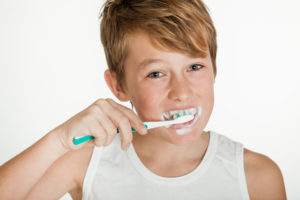
Having a good oral hygiene regimen will protect your child’s teeth from disease and keep their treatment plan on track. If teeth aren’t taken care of, orthodontic care can be slowed down as the orthodontist will have to address their cavities or tooth decay before treatment can continue. Brushing and flossing are essential before, during and after orthodontic care to keep teeth healthy and strong. Make sure that your teen is brushing with a fluoride toothpaste to strengthen their tooth enamel. Consistent flossing will also keep teeth decay-free by removing food particles that can get stuck and allow bacteria to grow. Additionally, using a fluoride mouthwash can aid brushing and flossing by adding the extra punch that teeth need to fight plaque and decay.
Scheduling A Consultation
If your teen would benefit from Invisalign, call Belmar Orthodontics today at (303) 225-9016! Our team of dedicated professionals is experienced with fitting Invisalign Teen and helping your child feel comfortable and satisfied during orthodontic treatment. Call today to begin your teen’s treatment for a beautiful, confident smile!
Is It Too Late For Me To Get Braces?

Most orthodontic patients receive their braces at a young age, typically during the teenage years. Are the teenage years the best time to receive braces, or will treatment work just as well as an adult? With the technological advances that have occurred, adult orthodontics have more options than ever to straighten smiles of all ages. Some benefits of adult orthodontics include correction of life-time dental issues, faster treatment time than former technology, and increased confidence. If you’re ready to change your smile, learn how adult orthodontics can help you through these tips!
Braces Throughout The Years
Modern advances in orthodontic treatment has revolutionized how quickly children and adults alike get the healthy and straight smiles they want, and allowed people of all ages to improve their oral health, no matter their age. For many years, traditional metal brackets were the only option to straighten teeth, but as technology has advanced, a variety of aesthetic bracket systems have been developed to give you the smile you want with braces that are less noticeable and easier to maintain. Permanent braces now come in two options: metal or ceramic. Ceramic braces are matched to teeth color, making them nearly invisible during treatment. Lingual braces are also an option, which are completely disguised from others as they are attached to the back of the teeth. Removable orthodontic appliances have recently come into play as a clear plastic aligner that is used and removed as needed. These aligners are advantageous to adults because they are less visible and easier to clean and maintain, which comes in handy for those adults busy with work and family life. As the options for braces have broadened throughout the years, so has the number of adult patients being treated for braces. Technological advances in the orthodontic industry now allows for more patients, even those who have passed the prime age for orthodontic care, to change their smiles during any part of life.
Benefits of Adult Orthodontics
The American Association of Orthodontists reports that of the 4.5 million Americans that are currently receiving orthodontic care, 25% of them are adults. Although childhood is the ideal time to receive braces, adult orthodontics has become a popular option for those who couldn’t receive treatment during adolescence. Some benefits of adult orthodontics include:
- More discreet treatment methods
- Correction of lifetime dental issues
- Faster treatment time
- Increased self-esteem and confidence
Adults ultimately have more options when choosing what braces and treatment plan is best for them. Orthodontic care protects both kids and adults against tooth decay, tooth loss, gum disease, impaired speech, chewing and jaw problems. While cost is a factor, you will still need an oral evaluation and orthodontics consultation to determine your candidacy for certain procedures and treatments. For the first time, adults of any age who have otherwise healthy teeth can benefit from orthodontic treatment at any point in life.
What To Expect With Adult Orthodontics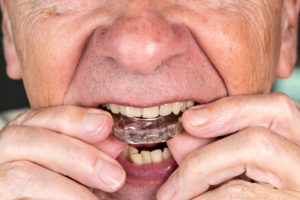
Typically, it is more difficult to manipulate an adult’s fully-developed jawbone compared to the pliable jawbone of a child, but modern-day advances now allow orthodontists to correct crooked teeth with great success and precision. Any oral health issues, such as periodontal (gum) disease, will have to be resolved before teeth can be straightened, so meeting with your dentist and orthodontist will be an important first step to take before treatment can begin. If you’re considering orthodontic treatment to correct any cosmetic or bite issues, consider the following:
- The entire process may take longer for an adult than a child. Typical treatment time averages two years, but varies from person to person.
- Fully-developed bones in adults have stopped growing, so some structural changes cannot be achieved without surgery.
- Adults may need to see a periodontist, as well as a dentist and orthodontist, to ensure that treatment will not be complicated by bone loss due to gum disease.
Adults who have had teeth removed in the past might have difficulties with orthodontic care as old extraction sites might not be suitable for teeth to move into. Adult patients receiving treatment also have a higher risk for root absorption than children do as their bodies reabsorb the root of the tooth, leaving no room for anchorage. This process causes teeth to loosen and fall out over time due to gum instability. Since braces and other appliances are cemented directly to the teeth themselves, it is important that all patients, even adults, maintain good oral health practices that will prevent the areas around the brackets from developing plaque and tooth decay, which will ensure that they get the best (and healthiest) smile possible.
Schedule An Appointment Today
If you are interested in adult orthodontics or are wanting to improve the look of your smile, call Belmar Orthodontics at (303) 225-9016 for a consultation to learn about which options are available for you. Our dedicated team of professionals are determined to help you get the smile that you want and improve your oral health!
Does Your Child Really Need Braces?

We typically get our braces put on during our teenage to adult years, but how do you know whether your young child should have braces or not? Child orthodontics is a common practice for those children struggling with crooked, overlapping, or overcrowded teeth, or a misaligned jaw. There are many advantages for children as they receive braces earlier on in life as it can prevent future orthodontic treatment and guide incoming teeth into the proper position. Learn how to recognize whether your child needs braces through these tips!
When To Start
Young kids go through a lot of physical changes during adolescence, and some of those changes include jaw and teeth development. Orthodontics has become more and more common in young children to adjust certain orthodontic issues that occasionally occur as a child develops. Traditionally, orthodontic treatment begins once a child has lost most of their baby (primary) teeth and a majority of their permanent teeth have grown in, which typically occurs between the ages of 8 and 14. Even though braces is recommended at this age, it is a good idea to get an orthodontic evaluation for your child by the time they turn 7 years old; at this age, an orthodontist is able to detect early symptoms of orthodontic problems, such as an underbite or crossbite, which can cause severe complications and more treatment later on if left untreated at an early age. Bones are still growing during this age, so it is an ideal time to meet with an orthodontist to monitor bone and jaw development while evaluating any apparent orthodontic issues.
Advantages of Child Orthodontics
Although child orthodontics is only necessary if there are physical developmental issues within the mouth, receiving orthodontic treatment as a child has certain advantages. Visiting an orthodontist at an early age allows for observation of incoming teeth and reduces the risk of impacted teeth as your child loses their baby teeth and their permanent teeth take their place. As the orthodontist monitors your child’s teeth, they can help guide their teeth into the correct position as soon as they begin erupting, usually through braces or other orthodontic devices that help move teeth into the correct positions. Regular orthodontic visits also decrease the risk of hidden dental issues and permanent tooth extractions, as it allows for the orthodontist to adjust the jaw so that teeth crowding doesn’t occur.
Child orthodontics doesn’t always imply braces. Since a child’s jaw and teeth are still growing, many orthodontic issues, such as crowding, can be addressed before complications occur later on during adolescence. In this case, orthodontic treatment in young children is known as interceptive orthodontics. Many times, a child’s dental arch may be too small to fit all of their teeth. Just a few decades ago, it was a common practice to simply remove some permanent teeth to make space in the mouth. Now, though, child orthodontics can avoid this through the use of a palatal expander that expands the child’s upper dental arch, which allows adult teeth to emerge in a better position. Interceptive orthodontics can speed up the process of aligning teeth into the proper position and cause future treatment to be shorter and less involved.
How Much Does It Cost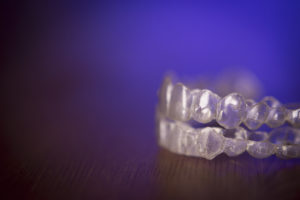
If braces are fit too early on a child, treatment can take longer and be more expensive. For this reason, it’s important to have regular orthodontic visits to monitor tooth and jaw development to ensure that whenever your child receives braces, it’s at the correct time. The braces that your orthodontist recommends will depend on your child’s type of problem that he or she has. There are three types of braces that most children will receive, and they each have different advantages and disadvantages:
- Traditional metal braces – Have steel ties holding the wires between the brackets in place. Cost is driven by what your orthodontist will charge for treatment, including multiple office visits.
- Damon braces – Do not have steel ties, but the brackets themselves hold the wires in place. Typically more expensive and can cost up to $8,000, but you pay for less dental appointments since the braces are self-ligating.
- Invisalign (or other clear or removable aligners) – Fit over the child’s teeth similar to a mouthguard. Your child will receive a number of aligners during the duration of their treatment, so cost is determined by the amount of aligners needed to achieve correction.
Just like adult orthodontics, child orthodontics can cost anywhere between $3,000 and $8,000, depending on what level of correction your child needs. If your child needs to have teeth extracted or be fitted for other appliances, the cost will most likely go up, as well. The way your child complies to orthodontic treatment will also affect the cost. Make sure that they are brushing and flossing everyday so as to avoid tooth decay, which will increase the cost of treatment as your dentist will have to treat around the braces to fix the decay.
Is It Necessary?
As mentioned before, whether your child needs braces or not at an earlier age is dependent upon their mouth structure and how their teeth form. For more information about child orthodontics or if you’re interested in scheduling a consultation, contact Belmar Orthodontics at (303) 225-9016!. Our experienced and highly trained orthodontic staff offers a variety of orthodontic treatments and technology so that you can be confident your children are receiving the best care available.
Temporary Anchorage Devices: What Are They?
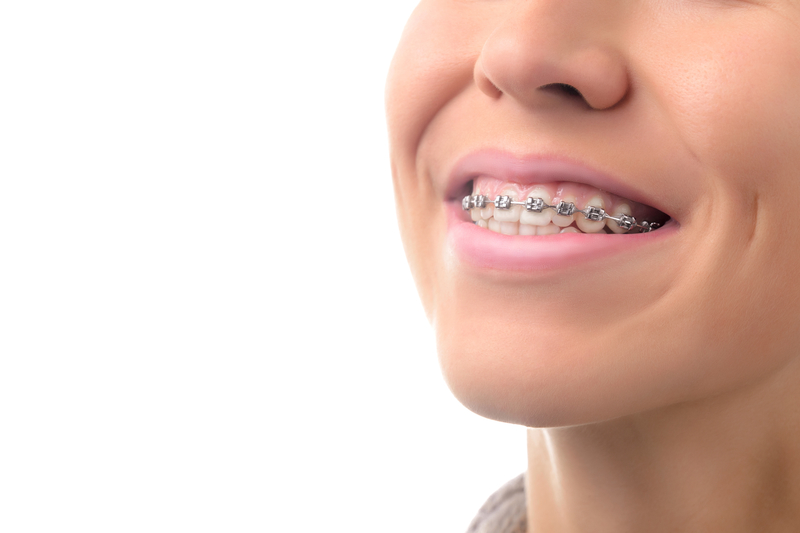
Whenever our teeth need an extra push to shift them into a straighter position, orthodontists will typically install a temporary anchorage device, commonly known as a “TAD.” Although they’re not used in every case, they help pull, push, and lift difficult to adjust teeth into the correct position. If your orthodontist recommends that you have a TAD, read through this guide to understand how they function and what you can do to maintain them!
Origins of Orthodontia
Poorly aligned jaws and teeth have been a nuisance to mankind since the beginning of time, so it’s no surprise that orthodontics has been around for so long. Archaeologists have found human remains with crooked teeth dating back 50,000 years; interestingly enough, the remains of some ancient civilizations, like Egypt, have been found with crude metal bands around their teeth, a form of orthodontics very similar to braces that we see nowadays. The ancient Greek, the Etruscans, and the Romans also practiced orthodontia and kept records of their discoveries. The ancient Greek physician, Hippocrates, was the first to describe teeth irregularities around 400 BC, and centuries later, Celcus would advise bringing newly emerging teeth into their proper position by pushing them with your fingers.
By the 1700 and 1800s, orthodontics was developing rapidly. Pierre Fauchard, the “Father of Dentistry,” would create the bandeau that allowed teeth to align correctly by using a strip of metal with regularly spaced holes that fit around the teeth. During the 20th century, Edward Hartley Angle would identify the true properties of a malocclusion, or misalignment, and begin addressing them with an effective set of orthodontic appliances that were developed much earlier. By the 1970s, braces would further advance through the invention of dental adhesives that would allow orthodontists to stick brackets to teeth surfaces rather than wiring them around each tooth. Stainless steel replaced gold and silver that were previously used as the wire, which helped reduce the cost of braces significantly. Even with the impressive advances that we have made since the beginning of orthodontics, patients around the world still suffer from advanced teeth and jaw malocclusion that normal braces can’t resolve on their own. For the purpose of increasing the effectiveness of braces, other orthodontic devices have been invented to facilitate this process.
Orthodontic Devices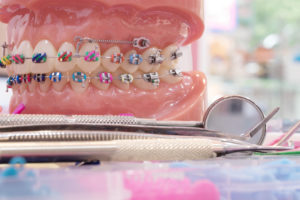
Whenever we think of “orthodontics,” we innately assume braces. Braces have two basic parts: brackets and wires. Wires move the teeth and brackets serve as a stationary holder for the wires. Contemporary braces can be stainless steel, gold-colored, or tooth-colored ceramic. Most braces go on the front of the teeth, but there are some, called lingual braces, that are fastened onto the backs of teeth that are virtually invisible. Lingual braces are not the same as clear aligners, which is another orthodontic device. Clear aligners are made of a transparent plastic-like material and are considered “invisible braces.” They are made to fit the patient’s teeth at different stages of treatment. Each set of aligners is worn for 1-3 weeks for at least 22 hours a day, and are designed to move the teeth incrementally until the next set is used. While these types of braces are a very common sight to see in many homes, schools, and workplaces, they aren’t the only devices used to move teeth and align jaws. Power chains are sometimes used with braces for an added push. They are stronger than the traditional elastic rings and can apply an extra force when needed. The last orthodontic device that is commonly used, although many patients don’t know what their purpose is, is a temporary anchorage device, or TAD.
TADs
Temporary anchorage devices, most commonly known as TADs, are used in some orthodontic cases to help shift the teeth into a straighter position when traditional braces can’t do it on their own. For this reason, not everyone needs them. TADS use titanium mini-screws (sometimes called mini-implants or micro-implants) that provide a fixed object that can be used to push, pull, lift, or intrude teeth that are being straightened. TADS don’t move and can be placed in many different parts of the mouth, so they are highly efficient at moving difficult teeth back into proper alignment. Before TADs are ever inserted into your mouth, though, your orthodontist will evaluate your teeth and determine whether your malocclusion is severe enough to receive a TAD. Before insertion, your gum tissue and jaw area will be numbed so that the procedure will be nearly painless. The TAD is then placed into your jawbone, and will eventually be removed once your orthodontist feels that it is no longer needed for straightening your teeth.
Just like braces, it may take a couple of days for the discomfort to subside and your mouth to get used to the TAD. Try taking an over-the-counter pain relief medication to alleviate any excessive discomfort. An important part of maintaining your TAD is continuing your oral hygiene regimen. Continue to brush your teeth at least twice a day and use mouthwash with antimicrobial ingredients. As long as your gums are healthy throughout the duration of your treatment, you shouldn’t have any complications with your TAD.
Get Straighter Teeth Today
To learn more about TADS, or to schedule an appointment to begin your treatment plan for braces, call Belmar Orthodontics at (303) 225-9016! At Belmar Orthodontics, we have a highly skilled and experienced team that is happy to help you start your journey to a healthier and happier smile.
